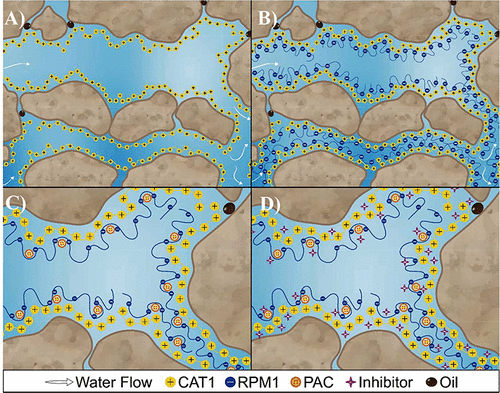当前位置:
X-MOL 学术
›
Ind. Eng. Chem. Res.
›
论文详情
Our official English website, www.x-mol.net, welcomes your
feedback! (Note: you will need to create a separate account there.)
Evaluation of Barium Sulfate Scale Inhibition Using Relative Permeability Modifier Polymers as Adsorption Enhancer for Mature Offshore Well Treatments in Campos Basin, Brazil
Industrial & Engineering Chemistry Research ( IF 3.8 ) Pub Date : 2018-08-16 , DOI: 10.1021/acs.iecr.8b01828 Daniel A. Maffra 1 , Tiago C. Freitas 2 , Georgiana F. da Cruz 1 , Fernando D. de Siqueira 1 , Francisca F. do Rosário 2
Industrial & Engineering Chemistry Research ( IF 3.8 ) Pub Date : 2018-08-16 , DOI: 10.1021/acs.iecr.8b01828 Daniel A. Maffra 1 , Tiago C. Freitas 2 , Georgiana F. da Cruz 1 , Fernando D. de Siqueira 1 , Francisca F. do Rosário 2
Affiliation

|
In many mature offshore fields, high water cuts and potential scale deposition are some of the toughest challenges operators need to face. Two common practices used to deal with these challenges are relative permeability modifiers (RPM) polymer injection and scale inhibitor squeeze treatments. Even though many fields face these two challenges simultaneously, little is known about concomitant application of these treatments. In this paper, the effect of applying RPM polymers prior to inhibitor squeeze in the effectiveness of the last treatment is evaluated for sandstone rocks of Campos Basin, Brazil. Sequential laboratory injections in Campos Basin rocks of commercial cationic and anionic polyacrylamide and polyaluminum chloride (PAC) as cross-linking agent were employed prior to the injection of a commercial organophosphonic acid type inhibitor for barium sulfate scale. It was found that the polymers employed are capable of reducing the permeability of porous media to water and increasing the retention time of the scale inhibitor simultaneously. The tests also indicated that the inhibitor’s longer retention time is associated with the interaction with an outer cationic layer of the cross-linking agent. The adsorption isotherms were calculated and compared with Langmuir, Freundlich, Sips, and Toth models, the last two being the most accurate in representing the adsorption system for these tests.
中文翻译:

使用相对渗透率改性剂聚合物作为吸附增强剂评估巴西坎波斯盆地成熟海上钻井的硫酸钡阻垢性能
在许多成熟的近海油田,高含水率和潜在的水垢沉积是运营商需要面对的最棘手的挑战。用来应对这些挑战的两种常用方法是相对渗透性调节剂(RPM)聚合物注射和阻垢剂挤压处理。尽管许多领域同时面对这两个挑战,但对这些疗法的同时应用知之甚少。在本文中,对巴西坎波斯盆地的砂岩岩石,评估了在挤压抑制剂之前先施加RPM聚合物对最后处理效果的效果。在Campos盆地岩石中按顺序进行实验室注入,使用商业阳离子和阴离子聚丙烯酰胺和聚氯化铝(PAC)作为交联剂,然后注入用于硫酸钡垢的商业有机膦酸型抑制剂。发现使用的聚合物能够降低多孔介质对水的渗透性并同时增加阻垢剂的保留时间。测试还表明,抑制剂的较长保留时间与与交联剂外阳离子层的相互作用有关。计算了吸附等温线,并将其与Langmuir,Freundlich,Sips和Toth模型进行了比较,后两个模型最能代表这些测试的吸附系统。发现使用的聚合物能够降低多孔介质对水的渗透性并同时增加阻垢剂的保留时间。测试还表明,抑制剂的较长保留时间与与交联剂外阳离子层的相互作用有关。计算了吸附等温线,并与Langmuir,Freundlich,Sips和Toth模型进行了比较,后两个模型最能代表这些测试的吸附系统。发现使用的聚合物能够降低多孔介质对水的渗透性并同时增加阻垢剂的保留时间。测试还表明,抑制剂的较长保留时间与与交联剂外阳离子层的相互作用有关。计算了吸附等温线,并将其与Langmuir,Freundlich,Sips和Toth模型进行了比较,后两个模型最能代表这些测试的吸附系统。
更新日期:2018-08-17
中文翻译:

使用相对渗透率改性剂聚合物作为吸附增强剂评估巴西坎波斯盆地成熟海上钻井的硫酸钡阻垢性能
在许多成熟的近海油田,高含水率和潜在的水垢沉积是运营商需要面对的最棘手的挑战。用来应对这些挑战的两种常用方法是相对渗透性调节剂(RPM)聚合物注射和阻垢剂挤压处理。尽管许多领域同时面对这两个挑战,但对这些疗法的同时应用知之甚少。在本文中,对巴西坎波斯盆地的砂岩岩石,评估了在挤压抑制剂之前先施加RPM聚合物对最后处理效果的效果。在Campos盆地岩石中按顺序进行实验室注入,使用商业阳离子和阴离子聚丙烯酰胺和聚氯化铝(PAC)作为交联剂,然后注入用于硫酸钡垢的商业有机膦酸型抑制剂。发现使用的聚合物能够降低多孔介质对水的渗透性并同时增加阻垢剂的保留时间。测试还表明,抑制剂的较长保留时间与与交联剂外阳离子层的相互作用有关。计算了吸附等温线,并将其与Langmuir,Freundlich,Sips和Toth模型进行了比较,后两个模型最能代表这些测试的吸附系统。发现使用的聚合物能够降低多孔介质对水的渗透性并同时增加阻垢剂的保留时间。测试还表明,抑制剂的较长保留时间与与交联剂外阳离子层的相互作用有关。计算了吸附等温线,并与Langmuir,Freundlich,Sips和Toth模型进行了比较,后两个模型最能代表这些测试的吸附系统。发现使用的聚合物能够降低多孔介质对水的渗透性并同时增加阻垢剂的保留时间。测试还表明,抑制剂的较长保留时间与与交联剂外阳离子层的相互作用有关。计算了吸附等温线,并将其与Langmuir,Freundlich,Sips和Toth模型进行了比较,后两个模型最能代表这些测试的吸附系统。











































 京公网安备 11010802027423号
京公网安备 11010802027423号